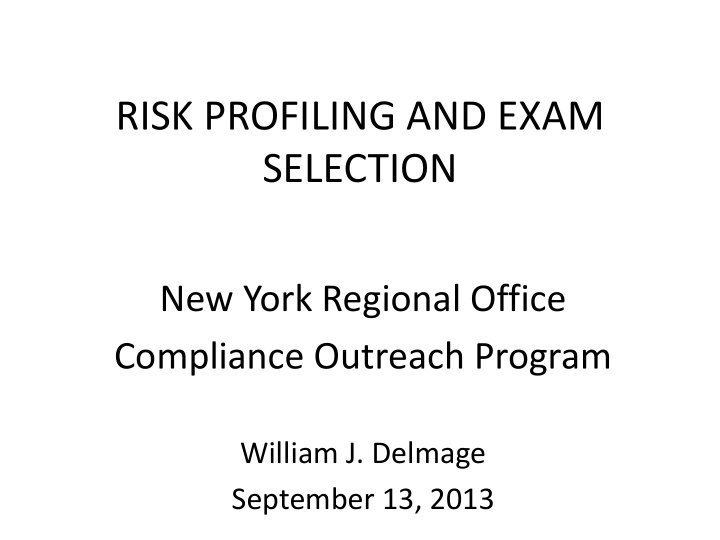



RISK PROFILING AND EXAM SELECTION New York Regional Office Compliance Outreach Program William J. Delmage September 13, 2013
T he Securities and Exchange Commission, as a matter of policy, disclaims responsibility for any private publication or statement by any of its employees. The views expressed herein are those of the author and do not necessarily reflect the views of the Commission or of the author’s colleagues upon the staff of the Commission.
AGENDA • Risk Based Exams • Risk Profiling Process • Exam Selection and Planning
Risk Based Exam Approach Risk Based Exams • Not a new concept for the exam program • We have followed the risk based approach for more than a decade • Reality of resources and mission • Process has evolved greatly of the past several years • Ability to conduct risk based exams goes hand in hand with our risk profiling efforts • Made efforts to access relevant information from outside sources as well as use the info we have more effectively
Risk Profiling Process Multi-part Process • National Level – Office of Risk Analysis and Surveillance (ORAS) – Screens all RIAs using an algorithm based on responses to Part 1 of Form ADV – Results in a specific Risk rating as well as potential operational red flags – ORAS also analyzes the data for specific trends or patterns – Maintains and analyzes data from various outside databases – Provides periodic and ad-hoc reports to Regional Offices – Process has made great strides over the past several years due to amendments made to Form ADV and ORAS as a dedicated resource
Risk Profiling Process Multi-part Process • Local Level – ORAS data is just a starting point – Regional Offices considers other factors outside of the ORAS rating such as: • Prior exam history and conduct • Exam staff research • Market events and trends • Tips, complaints and referrals • Media reports • Info from other regulators/SROs – This is the general process used for all RIA exams
Risk Profiling Process – New Registrants • Due to the requirements of the Dodd-Frank Act, 1,500 new firms registered with the SEC • Given this uptick in registrants, the staff explored different ways to gather insight into these firms outside of the staff’s normal processes • ORAS and the Regional Offices developed a tool to use for risk profiling these new registrants • Deeper dive into a firm using our internal resources without contacting the firm • Tool has identified specific risks and or red flags at firms that may warrant further exam efforts • This tool can also be used for any RIA registered with us
Exam Selection & Planning • The risk profiling work feeds into the staff’s regional exam plan for each fiscal year • Risk profiling may also determine the type of exam that the staff will conduct of a firm • The staff also has a number of other “buckets” of firms that the staff needs to profile and consider for its exam plan each year, including: – Major complexes and other large money managers – Firms rated high risk during prior exams – Never before examined firms (ex Dodd Frank firms) – Exams for Cause (TCRs, News Reports, Info from other regulators) – National and regional office priorities
Recommend
More recommend